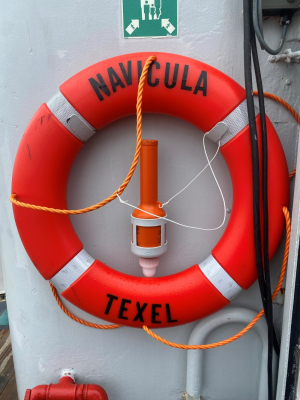
The Ems Dollart is a unique nature area, because it is one of the last places in the Netherlands where fresh river water and salt seawater meet. However, the natural movement of the rivers Ems and Dollart have been strongly restricted due of embankments, and consequently, the rivers can no longer overflow and deposit their sediment. Regular dredging is needed to keep the shipping channel navigable for large ships bound for Eemshaven, Delfzijl and Germany. As a result, the natural characteristics of the area have been affected, clay particles permanently float in the water and too much sludge from the North Sea is imported, which negatively affects the ecology in the area.
This week, the habitats and biodiversity of the Ems Dollart area will be sampled with a team of twelve researchers, volunteers and ships crew. The team is embarking in Eemshaven, where the NIOZ research vessel Navicula is docked. Upon arrival in Eemshaven, the view is not immediately reminiscent of a UNESCO world heritage nature area: on the horizon a large coal-fired power station and a lot of industry, with wide smoke plumes that colour the sky white. The ship Navicula has a distinctive appearance in the port, next to fishing trawlers and dredgers. Here, nature seems far away.

But when the crew is on board and the Navicula sails out of port, the familiar sight of the Wadden Sea appears. The salty air meets you, eider ducks float on the water, and terns fly through the air behind the ship, hoping for a meal that they usually find when fishing vessels operate in the area. The tide is preceding and the mudflats on both sides of the gulley slowly become visible above the water. During the day, a strong wind develops, pushing the waves up. The Navicula has been specially built for the Wadden Sea, meaning she has a fairly flat bottom and a shallow draft. This causes the ship to roll strongly on the waves. An hour later, the rain is pouring. But the crew continues to work hard and point after point is sampled.

The submerged Wadden Sea is investigated using a boxcorer, taking a 'bite' out of the sediment. The boxcorer hangs behind the ship, and sinks into the sea bottom due to weights attached above it. The sediment sample is then brought on deck. A 3D scan is made and a small sample of sediment is collected for analysis in the lab. The rest of the sample is sieved at a large sieving table, until all bottom animals and hard substrates remain, such as shellfish, worms, shells and stones. Some organisms are clearly visible, others are too small to see without a microscope. Everything that remains after sieving is sent to the lab, where all organisms will be identified and counted.
The sediment in the Ems Dollart area is diverse. Some boxes are mainly filled with sand. Regularly, balls of clay are mixed through the sediment. Several times, old peat layers are found, with the plants still clearly visible. Other times, the smell of rotting eggs is already strong before the box is well and truly on deck, and you know that the box is filled with mud.
When sieving, it is always a surprise too what you will find. Sometimes, only a small pile of broken empty shells remains after sieving. Other times, many American razor clams are found, an invasive species that has strongly increased in abundance in the Wadden Sea in recent decades. Live native bottom animals are often found too, such as the Baltic clam, soft-shell clams, worms and reefs of sand mason worms and mussels. And special finds, like American piddock, ribbed molluscs that dug themselves into the sediment, creating a perfect circle in old peat layers. And sea anemones and hydroid polyps, probably inhabited by ampihpoda (small crustaceans).
In the evening, the Navicula is at anchor in the Wadden Sea. When the sun has set, the silence on deck is impressive. Even in this area with intensive shipping, with the lights of industry still visible in the distance on the horizon, the sea has a silence you cannot find on the mainland. Not only the absence of sound, but also the clearly visible stars, the ship that slowly sways on the waves, the salty air, the absence of many people, and a feeling of naturalness one can only find at sea. The area still has something natural and truly special. An area where natural dynamics still predominate. A unique beauty we should cherish.
During this week at sea, 146 points have been sampled in the Ems Dollart area. The majority of the points were sampled from the Navicula, but some points where the water was too shallow for the ship were sampled from a small inflatable boat. The last day, it is a strange realisation: this was the last fieldwork day to map the subtidal Wadden Sea. Hopefully, it will not be the last time that the area will be sampled in this way, and the method will be incorporated in a regular biodiversity monitoring programme for the subtidal Wadden Sea.
This ecosystem will soon be better understood thanks to the project Wadden Mosaic. This will be essential for selecting effective management measures for the the permanently submerged Wadden Sea. So in the coming decades and centuries, the Wadden Sea can still rightfully be called a UNESCO world heritage site, forming a unique habitat for many species.














